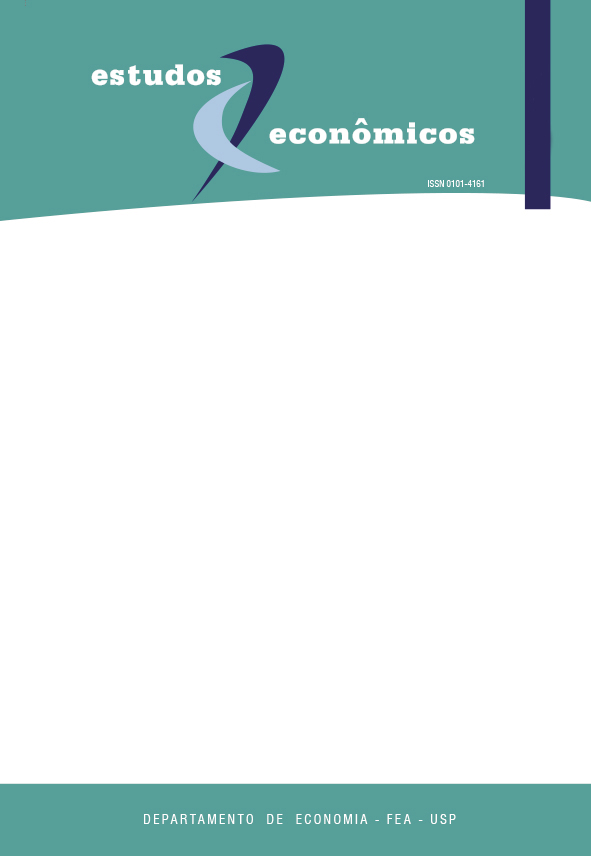Uma metodologia alternativa para mensuração de pressão sobre o mercado de câmbio
DOI:
https://doi.org/10.1590/S0101-41612004000100003Palavras-chave:
pressão sobre o mercado de câmbio, crise asiática, análise de agrupamentos, análise discriminanteResumo
Este artigo utiliza métodos estatísticos de análise multivariada para mensurar as pressões sobre os mercados cambiais de 20 países, no contexto da crise asiática de 1997/98. Desenvolve-se um índice de pressão sobre o mercado de câmbio atribuindo pesos positivos para desvalorizações cambiais e para mudanças nas taxas de juros e pesos negativos para reduções do estoque de reservas internacionais. Os pesos são obtidos a partir de uma medida de comunalidade de cada variável utilizada na análise. Com base no índice de pressão cambial classificam-se os países da amostra por meio do método de Ward para análise de agrupamentos, identificando-se os mais atingidos pela pressão cambial iniciada em meados de 1997. A classificação obtida é validada pelo uso de análise discriminante.Downloads
Referências
BIS - Bank For International Settlements. 68th Annual Report. 1998.
BLANCO, Herminio; GARBER, Peter M. Recurrent devaluation and speculative attacks on the Mexican peso. Journal of Political Economy, n. 4, p. 148-66, 1986.
CHATFIELD, C.; COLLINS, A. J. Introduction to multivariate analysis. Londres: Chapman and Hall, 1980.
CONOVER, W. J. Practical nonparametric statistics. Third Edition. John Wiley & Sons, Inc. 1999.
CUMBY, Robert E.; WIJNBERGEN, Sweder van. Financial policy and speculative runs with a crawling peg: Argentina, l978-l981. Journal of International Economics, n. 27, p. 111-127, 1989.
EICHENGREEN, B.; ROSE, Andrew K; WYPLOSZ, C. Exchange market mayhem: the antecedents and aftermath of speculative attacks. Economic Policy, n. 21, p. 249-312, outubro 1995.
EVERITT, B. S.; DER, G. A handbook of statistical analyses using SAS. Nova York: Chapman & Hall, 1996.
EVERITT, B. S.; DUNN, G. Applied multivariate data analysis. 2o ed. Londres: Arnold, 2001.
FRANKEL, J.; ROSE, Andrew K. Currency crashes in emerging markets: empirical indicators. NBER Working Paper, nr. 5437, Cambridge, Massachusetts: National Bureau of Economic Research, Janeiro 1996.
FURMAN, J.; STIGLITZ, J. Economic crises: evidence and insights from east Asia. Brookings Papers on Economic Activity, 2, p. 1-133, 1998.
GIRTON, L.; ROPER, D. A monetary model of exchange market pressure applied to the postwar Canadian experience. The American Economic Review, v. 67, n. II, p. 537-548, 1977.
GOLDBERG, Linda S. Predicting exchange rate crises. Mexico revisited. Journal of International Economics, n. 3, p. 413-430, 1994.
GOLDFAJN, Ilan; VALDÉS, Rodrigo O. Are currency crises predictable? IMF Working Paper. Washington: International Monetary Fund, n. 159, 1997.
GOLDSTEIN, M.; KAMINSKY, G. L.; REINHART, C. M. Assessing financial vulnerability - an early warning system for emerging markets.
Washington: Institute for International Economics, 2000. IFS. International Financial Statistics. Março 1998.
JOHNSTON, Richard A.; WICHERN, Dean W. [1982]. Applied multivariate statistical analysis. 3a. ed. Nova Jersey: Prentice-Hall, Inc., 1992.
KAMINSKY, G.; LIZONDO, S.; REINHART, Carmen M. Leading indicators of currency crises. IMF Working Paper. Washington: International Monetary Fund, n. 79, julho 1997.
KAMINSKY, G.; REINHART, Carmen M. The twin crises: the causes of banking and balance-of-payments problems. The American Economic Review, v. 89, n. 3, p. 473-500, 1999.
MANLY, Bryan F. J. [1986] Multivariate statistical methods - a primer. Londres: 2ª ed., Chapman & Hall, 1994.
MELICK, William R. Estimation of speculative attacks models: Mexico yet again. IMF Working Paper.Basle: Bank for International Settlements
n. 36, 1996.
MIRANDA, Mauro C. Crises cambiais e ataques especulativos no Brasil - janeiro de l982 a janeiro de l999. 1999. Dissertação (Mestrado em Economia), UNB, Brasília.
OTKER, I.; PAZARBASIOGLU, C. Speculative attacks and currency crises: the Mexican experience. IMF Working Paper. Washington: International Monetary Fund, n. 112, 1995.
RADELET, S.; SACHS. The east Asian financial crisis: diagnosis, remedies, prospects. Brookings Papers on Economic Activity, 1, p. 1-90, 1998.
TREUHERZ, Rolf M. Manual das crises para países emergentes. São Paulo: Editora Futura, 2000
WEYMEARK, D. A general approach to measuring exchange market pressure. Oxford Economic Papers, n. 50, p. 106-121, 1998.
WORLD ECONOMIC OUTLOOK. Financial crises - causes and indicators. International Monetary Fund, abril 1999.
Downloads
Publicado
Edição
Seção
Licença
Copyright (c) 2004 Tito Belchior Silva Moreira, Maurício Barata de Paula Pinto, Geraldo da Silva e Souza

Este trabalho está licenciado sob uma licença Creative Commons Attribution-NonCommercial 4.0 International License.
A submissão de artigo autoriza sua publicação e implica o compromisso de que o mesmo material não esteja sendo submetido a outro periódico.
A revista não paga direitos autorais aos autores dos artigos publicados.





 Atualizado em 14/08/2025
Atualizado em 14/08/2025